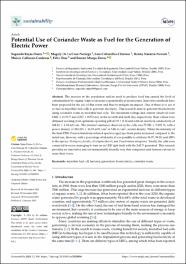| dc.contributor.author | Rojas-Flores, Segundo | |
| dc.contributor.author | De La Cruz-Noriega, Magaly | |
| dc.contributor.author | Cabanillas-Chirinos, Luis | |
| dc.contributor.author | Nazario-Naveda, Renny | |
| dc.contributor.author | Gallozzo-Cardenas, Moisés | |
| dc.contributor.author | Diaz, Félix | |
| dc.contributor.author | Murga-Torres, Emzon | |
| dc.date.accessioned | 2023-10-18T17:39:29Z | |
| dc.date.available | 2023-10-18T17:39:29Z | |
| dc.date.issued | 2023-01-04 | |
| dc.identifier.uri | https://hdl.handle.net/20.500.13053/9576 | |
| dc.description.abstract | “The increase in the population and its need to produce food has caused the level of
contamination by organic waste to increase exponentially in recent years. Innovative methods have
been proposed for the use of this waste and thus to mitigate its impact. One of these is to use it
as fuel in microbial fuel cells to generate electricity. This research aims to generate bioelectricity
using coriander waste in microbial fuel cells. The maximum voltage and current observed were
0.882 ± 0.154 V and 2.287 ± 0.072 mA on the seventh and tenth day, respectively, these values were
obtained working at an optimum operating pH of 3.9 ± 0.16 and with an electrical conductivity of
160.42 ± 4.54 mS/cm. The internal resistance observed in the cells was 75.581 ± 5.892 Ω, with a
power density of 304.325 ± 16.51 mW/cm2 at 5.06 A/cm2
current density. While the intensity of
the final FTIR (Fourier transform infrared spectroscopy) spectrum peaks decreased compared to the
initial one, likewise, with a percentage of identity, it was possible to attribute 98.97, 99.39, and 100%
to the species Alcaligenes faecalis, Alcaligenes faecali, and Pseudomonas aeruginosa. Finally, the cells were
connected in series, managing to turn on an LED light (red) with the 2.61 V generated. This research
provides an innovative and environmentally friendly way that companies and farmers can use to
reuse their waste“ | es_PE |
| dc.format | application/pdf | es_PE |
| dc.language.iso | eng | es_PE |
| dc.publisher | MDPI | es_PE |
| dc.rights | info:eu-repo/semantics/openAccess | es_PE |
| dc.rights.uri | https://creativecommons.org/licenses/by/4.0/ | es_PE |
| dc.subject | microbial fuel cell; bacteria; generation; bioelectricity; coriander waste | es_PE |
| dc.title | Potential Use of Coriander Waste as Fuel for the Generation of Electric Power | es_PE |
| dc.type | info:eu-repo/semantics/article | es_PE |
| dc.identifier.doi | 10.3390/su15020896 | |
| dc.type.version | info:eu-repo/semantics/publishedVersion | es_PE |
| dc.publisher.country | CHE | es_PE |
| dc.subject.ocde | 3.03.00 -- Ciencias de la salud | es_PE |


